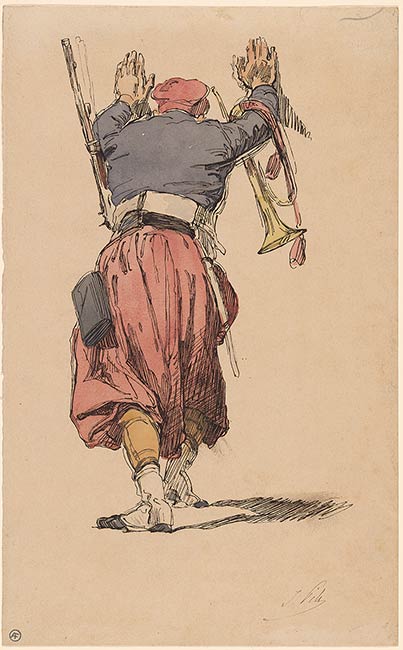
As one of Napoleon III's preferred realist painters, Isidore Pils was invited to accompany the French army on military expeditions, making sketches in ink and watercolor that he would consult for his later paintings. These watercolors were first exhibited at the Salon of 1855 and helped establish his career as a specialist in the medium.
Here, Pils depicted a Zoave officer leaning against a wall, supported by his hands, with his rifle to one side and bugle to the other. The Zoaves were a light infantry regiment of the French army, instituted in 1830, the year France invaded Algiers. Initially meant to comprise Berber troops in Algeria who had trained under Ottoman rule, the regiments soon comprised primarily French soldiers or those of French descent in North Africa. Artists frequently depicted the colorful uniforms of the Zoaves, and Pils, who specialized in military subjects, featured them repeatedly in his paintings and watercolors. This drawing is one of several portrayals of riflemen and buglers from the regiment, though more abstract and less detailed, perhaps because it was intended to be reproduced. The typical red fez with a tassel and voluminous trousers, worn with a short blue jacket with braiding, waistcoat, sash, and white gaiters, provided a colorful effect.
According to an inscription on the old backing, this drawing was reproduced in 1876 by printmaker and illustrator Paul Renouard (1845-1924), Pils' student, in the popular Parisian journal “L'Art.”
Inscribed at lower right in black ink, "I. Pils"; inscribed on old backing in graphite, "Dessin de Pils a été réduit par P. Renouard et publié dans l'Art - année 1876. Tome I page /232".
Collector's mark at lower left: "AF" encircled (Lugt 3627).
McCrindle, Joseph F., former owner.
"French and Continental Drawings, Watercolors, Paintings and Sculpture of the Nineteenth Century," Spring Exhibition 1982. Shepherd Gallery, New York.
